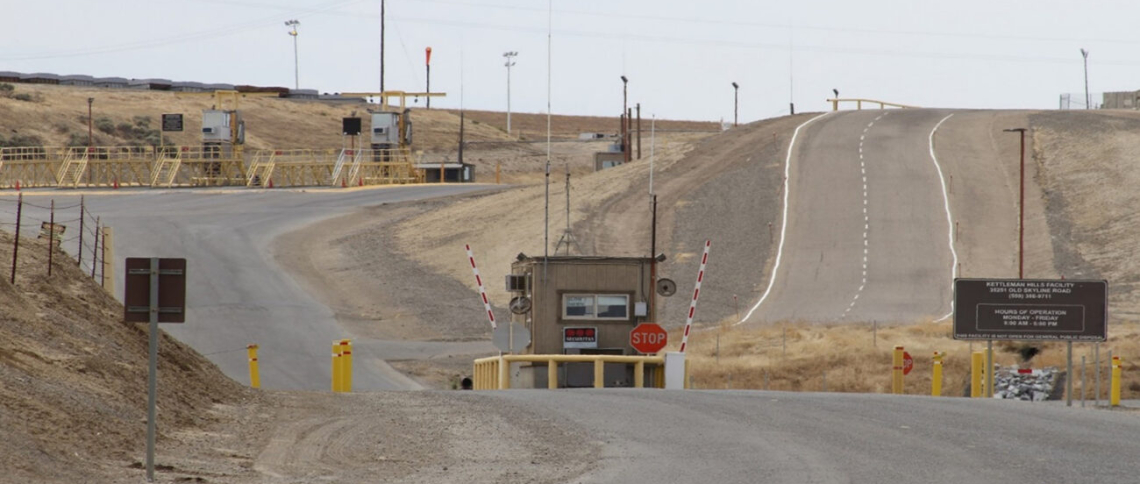
The entrance to Waste Management's Kettleman HIlls Facility, a hazardous waste landfill in Kings County. DTSC photo
Written by DORANY PINEDA Associated Press
(AP) — California shouldn’t weaken hazardous waste rules to allow local landfills to accept toxic dirt that currently goes to two specialized disposal sites in the Central Valley and hazardous facilities in other states, the state Board of Environmental Safety voted Thursday.
The vote went against a proposal by the Department of Toxic Substances Control that had prompted fierce opposition from environmental groups.
“I think they have been really listening to the community,” said Melissa Bumstead with the advocacy group Parents Against the Santa Susana Field Lab.
California’s hazardous waste laws are stricter than the federal government’s, and the state has long transported much of the waste it considers hazardous to other states with more lenient rules.
The Department of Toxic Substances Control said disposing more waste in state would likely reduce costs and truck emissions. But environmental advocates worried the plan could have exposed already vulnerable communities to contaminated waste and set the precedent for more rules to be weakened.
“I don’t think that municipal waste landfills were ever designed to accept this kind of waste, and to deregulate it … puts those landfill communities” at risk, said Jane Williams, executive director of California Communities Against Toxics.
California only has two hazardous waste landfills — Buttonwillow and Kettleman Hills in the San Joaquin Valley — which are expected to reach capacity by 2039, according to a report by the department. An estimated 47% of California’s hazardous waste is trucked across state borders. Contaminated soil, waste oil and mixed oil are the state’s three largest annual sources of hazardous waste. On average, more than 567,000 tons (514,373 metric tons) of toxic soil are produced every year.
Los Angeles wildfires raised awareness of the issue
The hearing comes months after wildfires in Los Angeles incinerated cars, homes and everything in them, turning ordinary objects into hundreds of tons of hazardous waste requiring specialized cleanup. It was the largest wildfire hazardous materials cleanup in the EPA’s history.
The infernos have also raised concerns about toxic ash and soil. Just this week, the Pasadena Unified School District published soil testing results showing high levels of arsenic or brain-damaging lead in nearly half its schools.
After the fires, hazardous waste was sent to temporary sites to be separated and packaged before most of it was trucked to Utah, Arizona, Nebraska and Arkansas. Two facilities were in California — in Wilmington, near the port of Long Beach, and Buttonwillow. The type and amount of waste deposited in them varies by site, but it includes oil, radioactive materials, paint residue, asbestos, controlled substances and fluorescent lamps.
“I think that the fires have really brought to the fore some long-standing issues,” said Angela Johnson Meszaros with the environmental law group Earthjustice. “And one of them is, how are we going to deal with cleanup, right? Because fires are not the only thing that cause soil to be hazardous.”
A state law passed in 2021 set out to reform the Department of Toxic Substances Control. In March, the department released a draft plan of sweeping proposals that would guide state and local hazardous management.
The board is expected to make a final decision in the summer, and it’s not clear if the department could go against the board’s wishes not to weaken the hazardous waste disposal rule.
Board member Alexis Strauss Hacker recalled how concerned people were about the proposal during their March meeting in Fresno. The fear, she said, was “so palpable.”
Although California has decreased its hazardous waste by more than 40% since 2000, lithium-ion batteries and other types of waste are expected to increase, the report says, and the state currently lacks the capacity to manage them. Lithium-ion batteries are found in common items such as electronic vehicles, cellphones and laptops.
Decades of industrial environmental pollution can accumulate, too.
The issue is personal for one activist
Bumstead has lived near the heavily polluted Santa Susana Field Laboratory in Southern California, once a site for rocket testing and nuclear reactor development.
Her 15-year-old daughter is a two-time cancer survivor, and Bumstead was born with three spleens. She believes her family’s health issues are linked to pollution from the nearby site. So when she heard that California environmental regulators wanted to weaken hazardous waste disposal rules in a bid to dump toxic soil into local landfills, she was very concerned.
The Los Angeles fires have made more people realize that toxic materials could end up in their backyard, Bumstead said.
“The more we see climate change, the more we see wildfires, the more this is going to become a front line issue,” she told the board. “This is an opportunity not just for hazardous waste that is manufactured, but also hazardous waste that is created by wildfires on how to create a plan that is going to protect Californians in the future.”








